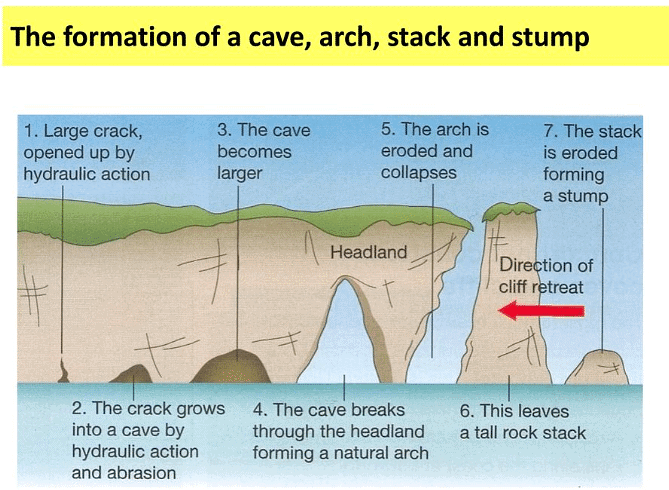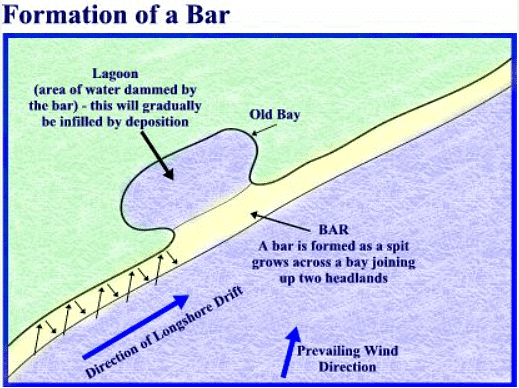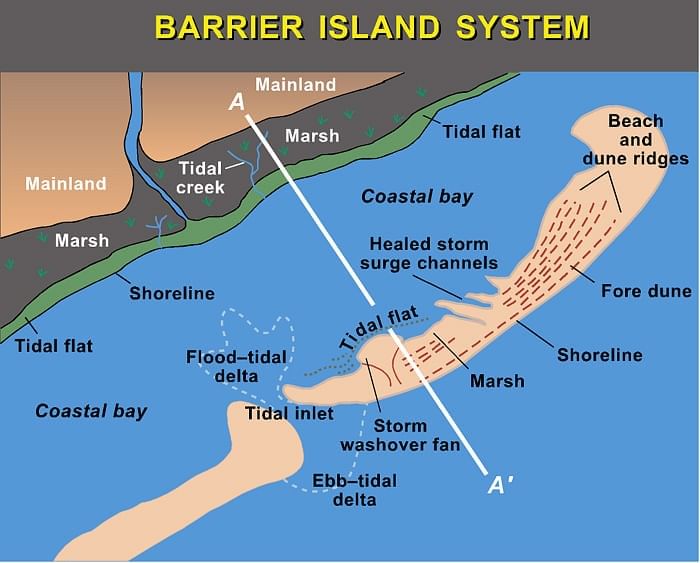Class 10 Exam > Class 10 Notes > Geography for GCSE/IGCSE > Coastal Landforms
Coastal Landforms | Geography for GCSE/IGCSE - Class 10 PDF Download
| Table of contents |

|
| Erosional Landforms |

|
| Headlands and bay |

|
| Caves, arches and stacks |

|
| Depositional Landforms |

|
Erosional Landforms
- Cliffs are formations of steep or gently sloping rocks, their profiles influenced by geological characteristics and surrounding topography.
- The angle of a cliff face is determined by geological factors and the intensity of wave erosion at its base, where high-energy waves are more destructive than low-energy ones.
- Many cliffs feature a 'knick-point' near the high-water mark, known as the 'wave-cut notch,' formed by wave undercutting.
- Abrasion, corrosion, and hydraulic action further erode the notch, extending it backward into the cliff.
- As undercutting persists, the cliff above becomes unsupported and unstable, eventually leading to collapse.
- The backwash of waves removes the eroded material, leaving behind a wave-cut platform.
- This process repeats, causing the cliff to continue retreating, resulting in coastal erosion.
The process of cliff retreat and wave-cut platform formation:

Headlands and bay
- These features are typically located in regions where layers of durable (hard) and less durable (soft) rocks alternate, creating a discordant coastline.Initially, erosion targets the less durable rock, such as clay, carving out a bay.
- A bay refers to a sea inlet where the land curves inward, often featuring a beach.
- Meanwhile, the more resilient rock, like limestone, remains projecting outward into the sea, forming a headland.

- A headland typically features cliffs along its sides, projects out to sea, is usually longer than it is wide, and consists of resistant rock.
- A bay usually has a wide, open entrance from the sea, a roughly semi-circular shape extending into the coastline, land that is lower than the surrounding headlands, and may or may not have a beach.
Question for Coastal LandformsTry yourself: What is the main factor that influences the angle of a cliff face?View Solution
Caves, arches and stacks
- When waves approach the shore, their velocity decreases as they encounter the seabed.
- This alters the wave direction, causing the crests to align parallel to the coastline, a phenomenon known as wave refraction.
- Refraction concentrates erosive forces on all sides of the headland.
- Weaknesses in the headland are exploited by hydraulic action, abrasion, and corrosion.
- As cracks widen, abrasion begins to erode the forming cave.
- The cave expands over time, eventually breaking through the headland to create an arch.
- Erosion continues to widen and thin the arch's base, both from below by wave action and from above by weathering.
- Ultimately, the arch's roof collapses, leaving a solitary rock column known as a stack.
- The stack is undercut at its base by wave action and weathering from above until it crumbles, forming a stump.

Depositional Landforms
Beach
- Beaches typically form in protected areas like bays.
- Deposition takes place via constructive wave action, where the swash is stronger than the backwash.
- Beach formation commonly occurs during calmer summer months.
- Occasionally, strong winds may carry offshore sand onto the shore.
- This blown sand can accumulate and create sand dunes in the beach's backshore.
Spit
- A spit is an elongated strip of sand or shingle extending from the shoreline into the sea.
- Spit formation is triggered by changes in coastline shape or the presence of a river mouth, preventing a spit from forming across the estuary.
- The shape of a spit, including whether it has a curved end, depends on wind and current directions.
- A notable example is Spurn Point, which spans three and a half miles across the Humber Estuary in northeast England.
Formation Stages
- Sediment is transported by longshore drift along the coastline.
- When the coastline changes direction, shallow, sheltered areas facilitate sediment deposition.
- Increased friction leads to further deposition.
- Over time, a spit gradually builds up to sea level and extends.
- Changes in wind direction can alter wave patterns, resulting in a hooked end for the spit.
- The area behind the spit becomes sheltered, allowing for the deposition of silts that form salt marshes or mud flats.

Bar
- A bar occurs when a spit connects two headlands across a bay.
- It results in the formation of a sandbar, which can also develop offshore due to wave action.

Lagoon
- A lagoon is a small body of water separated from the sea.
- It may form behind a bar or tombolo but is not permanent and can fill with sediment, creating new land.
Tombolo
- A tombolo forms when a spit connects the mainland to an island.
- An example is Chesil Beach in Dorset, which links the mainland to the Isle of Portland.
Barrier Island
- Barrier islands develop alongside the coast in a parallel formation.
- The primary distinction between a bar and a barrier island lies in their connectivity to the mainland and water bodies. A bar connects two headlands, while a barrier island is open at one or both ends.

Sand dunes
- Sand dunes are characterized by their dynamic nature, undergoing rapid changes.
- Typically, sandy beaches are accompanied by sand dunes, resulting from strong onshore winds carrying dried-out, exposed sand.
- Dunes are formed when sand grains are caught and deposited against obstacles like debris, rocks, or driftwood.
- Onshore winds push the seaward side of dune ridges towards the leeward side, causing them to move inland.
- The formation of sand dunes is facilitated by the interplay between winds and vegetation.
Formation of a sand dune
- Windblown sand accumulates against barriers such as pebbles or driftwood.
- With the capture of more sand particles, dunes expand, organizing into rows perpendicular to the prevailing wind direction.
- Over time, vegetation colonizes and stabilizes the ridges of the dunes through a process known as succession.
- Pioneer plant species, the first to establish, encounter challenges such as:
a. Salinity.
b. Scarce moisture due to rapid drainage of sand (high permeability).
c. Wind exposure.
d. Temporary burial by wind-blown sand.
e. Rising sea levels.
Embryo Dunes
- Wind-blown dry sand is trapped by debris, initiating deposition.
- Pioneer species like Lyme Grass and Sea Couch Grass start to establish.
- Soil content is minimal, and pH levels are high (alkaline).
- Embryo dunes are delicate and typically reach a maximum height of 1 meter.
Fore Dunes
- Embryo dunes provide some shelter from the prevailing wind.
- This allows for the growth of other plant species like Marram Grass.
- Marram grass begins to stabilize the dune with its root system.
- These plants contribute organic matter to the dunes, enhancing their suitability for subsequent plant growth.
- A microclimate forms in the dune slack.
- Fore dunes can reach a maximum height of 5 meters.
Yellow Dunes
- Initially, these dunes have a yellow hue which darkens over time as organic material enriches the soil.
- Marram grass remains dominant, but more delicate flowering plants and insects inhabit the dune slacks.
- Exposed sand decreases to 20% from an initial 80%.
- Maximum height does not exceed 8 meters.
Grey Dunes
- Grey dunes are more stable, with less than 10% of sand exposed, and exhibit greater biodiversity.
- Soil acidity and water content increase with the accumulation of humus.
- Shrubs and bushes start to appear.
- Height ranges from 8 to 10 meters.
Mature Dunes
- These are the oldest and most stable dunes, located several hundred meters or more from the shoreline.
- The soil can support diverse flora and fauna, including oak trees and alders, representing the climax vegetation.
- Mature dunes mark the final stage in succession, known as the climax community stage.
Question for Coastal LandformsTry yourself: What is the process by which a cave evolves into an arch?View Solution
The document Coastal Landforms | Geography for GCSE/IGCSE - Class 10 is a part of the Class 10 Course Geography for GCSE/IGCSE.
All you need of Class 10 at this link: Class 10
|
55 videos|68 docs|78 tests
|
FAQs on Coastal Landforms - Geography for GCSE/IGCSE - Class 10
| 1. What are erosional landforms formed by coastal processes? |  |
Ans. Erosional landforms formed by coastal processes include headlands and bays, caves, arches, and stacks.
| 2. What are some examples of depositional landforms found along coastlines? |  |
Ans. Some examples of depositional landforms found along coastlines include beaches, spits, and barrier islands.
| 3. How do headlands and bays differ in terms of their formation and characteristics? |  |
Ans. Headlands are formed when the sea erodes the land, creating a promontory that juts out into the water, while bays are indentations in the coastline where the sea has eroded the land behind a headland.
| 4. How are caves, arches, and stacks created along coastal areas? |  |
Ans. Caves are formed by the erosion of weak areas in the rock by the action of waves, arches are created when a cave erodes through to the other side of a headland, and stacks are isolated columns of rock that are left behind as the coastline erodes.
| 5. What role does deposition play in shaping coastal landscapes? |  |
Ans. Deposition plays a crucial role in shaping coastal landscapes by adding sediment to the coastline, creating features such as beaches, spits, and barrier islands.
Related Searches














